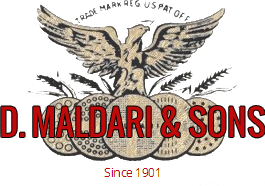Maintenance Services
- Preventive Maintenance on Dies revolves itself into both quality and quantity control of products. For improved quality we strive to control obvious flaws ion appearance such as dough rings, roughness, splits, breakage, collapsing, color, uneven wall thickness, raggedness and shape. For increased and continuing production we strive to control hidden difficulties which may be encountered in drying, packaging and handling.
- Our facilities stand ready to make all necessary repairs as expeditiously as possible.
- Call D. Maldari & Sons Today to Learn More – (718) 499-3555 or Email us at: info@maldari.com
A Proper Lesson in Die Maintenance
- To control product quality and quantity, eliminating flaws such as dough rings, roughness, splits, breakage, collapsing, uneven wallthickness and poor color and shape, dies should be returned for repair and reconditioning at intervals of 3 to 6 months. End result, trouble-free operation and maximum production output.
- reventive maintenance on Dies resolves itself into both quality and quantity control of your products. In the first category, we strive to control obvious flaws in appearance such as roughness, splits, breakage, collapsing, color, uneven wall thickness, and shape. In the second category, we strive to control hidden difficulties which may be encountered in drying, packaging and handling.
- Product flaws are danger signs which demand immediate investigation and correction. The source of difficulty is not always easy to ascertain, and a wide diversion of opinion may result.
- Under normal circumstances, we become conscious of Die wear through the warning medium of packages – too heavy a product results in less volume per unity weight giving too much slack in packages. This applies predominantly to the solid and tubular products where gradual wear can seldom be detected by visual measurement. The fancy products generally give some indication of wear by a change in physical appearance. Sea shells tend towards greater curvature, wavy-edge products towards a more pronounced wave, spiral products towards a tighter curl.
- Proper Die maintenance now becomes crucial. Upon removal from the press, the Die should be placed in a Die washer and cleaned thoroughly making certain that the water temperature does not exceed 110 degrees Fahrenheit. When using new high-technology Die washers, it will no longer be necessary to pre-soak the Dies because it has been found that the washing procedure is far more efficient if the dough has not been softened by pre-soaking.
- After the Die has been thoroughly cleaned, it should be inspected to make certain the outlets are clean, the pins centered where applicable, the surface is straight and not bowed, there is no knife damage to the surface, and extruding outlets are in good condition. The Die should then be placed in its storage rack.
- It is good operational procedure to warm the Die in warm water before again being used for production.
- In the interest of efficiency, it is suggested that future needs be projected and spare replacement inserts be pre-ordered to avoid loss of production time.
Steps for Proper Die Maintenance – “Proper Die Maintenance = Consistent Quality Products
- Handling: The careful handling of dies is of extreme importance. Caution should be the watchword to make certain the inserts/outlets are not damaged during unpacking or movement of dies through the plant. Dies should not be rolled to move them from one place to another.
- Inserts: Upon production acceptance of new inserts, replacement inserts should be ordered. We will manufacture and store replacement inserts at our plant with billing at time of completion of inserts. This procedure will give you the advantage of immediate die repair. Upon receipt of your worn die, we will replace the inserts and return the die within three (3) to five (5) days. On certain high volume products new inserts may be stocked at your plant for self-installation. Every pasta plant should have personnel trained to install inserts.
- Die Washing: This procedure is of extreme importance in both proper maintenance and performance of dies. Dies must be thoroughly cleaned because any matter left in the die could have possible detrimental effects on the inserts and the end product. When washing or soaking dies water temperature is of critical importance and should not exceed 140 degrees Fahrenheit. Higher temperatures may distort Teflon or UHMW components of the inserts.
Damaged Inserts: We always include 5% spare inserts with each order at no charge for immediate replacement of damaged or poor performing inserts.
Bent Dies: Cut off of the product will be seriously affected should the die yield during production because the knife will not move flat against the die surface. This will cause possible product distortion. Inspection for die flatness should be performed on a regular basis. At no time should a bent die be machined or ground to eliminate the knife catching on inserts. This will decrease the life of the die step as well as decrease the forming thickness of the insert
- Pre-Storage Inspection: After the die has been thoroughly washed, it should be inspected to make certain the outlets are clean with no dough residue or grit, the pins are centered where applicable, the surface is straight and not bowed, there is no knife damage to the surface, and extruding outlets are in good condition. The die should then be placed in its storage rack.

